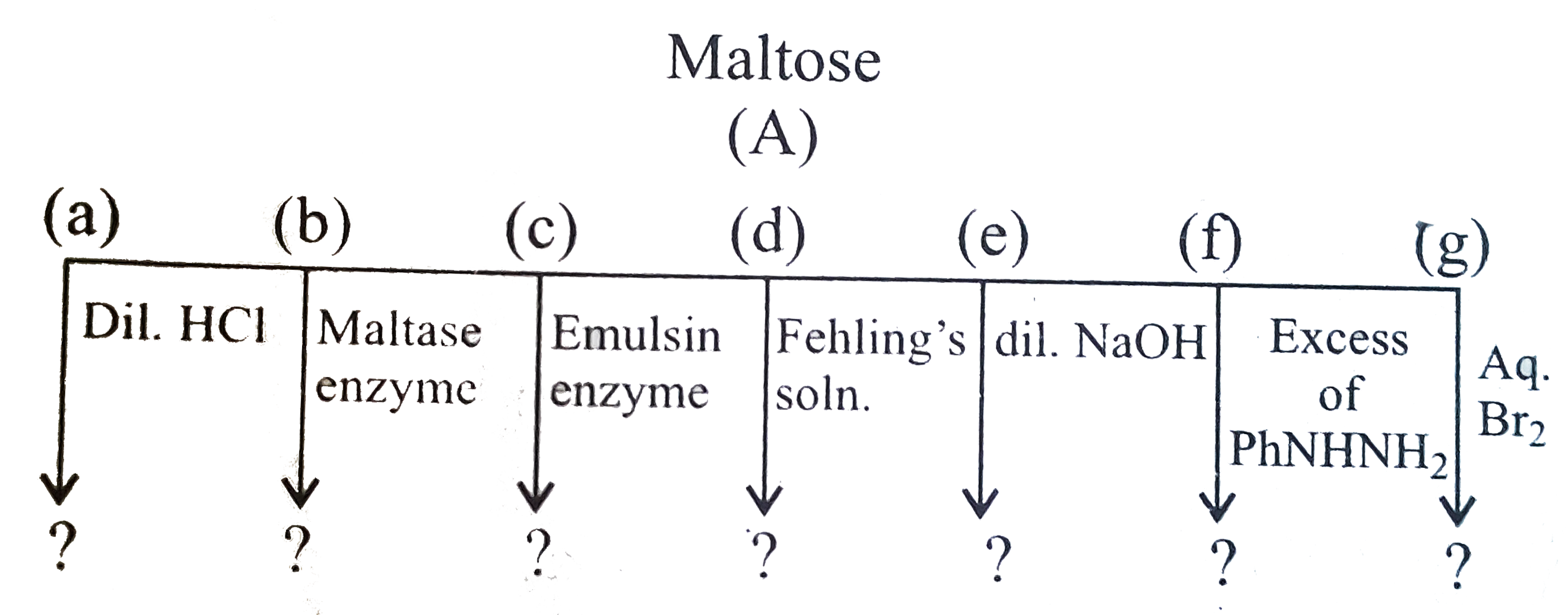Complete Solutions to Illustration of chapter BIOMOLECULES of Class 12 book with complete answers and questions
| Class 12 | CHEMISTRY |
| Chapter | BIOMOLECULES |
| CENGAGE CHEMISTRY | Illustration |
| Number Of Questions | 20 |
| Academic Year | 2023-24 |
Distinguish between `alpha-D`-gluecop-yranose `(I)` and methyl `alpha-D`-gluocopyranoside `(II)`.
View SolutionWrite the structures obtained by the epimerisation of `alpha-D`-gluocose at `C-2,C-3`, and `C-4(OH)` groups.
View SolutionExplain, in neutral or basic aqueous solution, glycosides do not show mutarotation, but in acidic medium they show mutarotation.
View SolutionComplete the following reactions:
(a). `OCH-(CHOH)_(4)CH_(2)Ohunderset(5HIO_(4))(rarr)`
(b). `HOCH_(2)-overset(O)overset(||)(C )-(CHOH)_(3)-CH_(2)Ohoverset(5HIO_(4))(rarr)`
(c ).`O=HC-underset(O)underset(||)(C)-underset(("Onsone"))((CHOH)_(3)CH_(2)OH)overset(zn//ACOH)(rarr)`
View Solution(a). Glucose and fructose form the same osazone, what does it prove?
(b). Why more than `3mol "of"PhNHNH_(2)` do not react with glucose and fructose and how does `PhNHNH_(2),` which is a powerful reducting agent, act as an oxidising agent in this case?
View SolutionComplete the following reactions

View Solution(a). Why is `beta-D-`gllucopyranose the most abundant of naturally occurring aldohexoses?
(b). Write the most stable chair conformer for `alpha-D-` fructopyranose. How does it dirrer from `beta-`anomer?
View Solution(a). What is the average molecular mass of starch?
(b). What is the approximate average number of glucose units in the sample of starch?
`(Given: 20 gm L^(-1)` of starch has an osmotic pressure `=10^(-2) atm at 25^(@)C.)`
View SolutionThe specific rotation of `alpha-`glucose is `+112^(@)` and `beta-`glucose is `+19^(@)` and the specific rotation of the constant equilibrium mixture is `+52.7^(@)`. Calculate the percentage composition of anomers `(alpha and beta)` in the equilibrium mixture.
View SolutionGive the steps for the conversion of `D-`glucose to `D-`fructose and vice versa.
View SolutionExplain why aldoses react with bendict's solution and `PhNHNH_(2)`, but not with `NaHSO_(3)`.
View SolutionA tripeptide oon complete hydrolysis gives glycine, alanine, and phenylanine,using three-letter symbols write down the possible sequences of the tripeptide.
View SolutionA dipetide on hydrolysis gives two amino acids.
`(A)NH_(2)underset(R )underset(|)(C )HCOOH and (B)H_(2)Nunderset(R')underset(|)(C )HCOOH`
The dipetide is also hydrolyses by leucine amino peptidase enzyme giving amino acid `(B)`. What is the structure of dipeptide?
View SolutionGive reason to explain why:
Gases are so easily compressible whereas it is impossible to compress a solid or a liquid.
View SolutionThe two samples of `DNA,` `A` and `B` have melting tempreatures `(T_(m)) 340` and `350 K`,respectively. Can you draw any conclusion from this data regarding their base content?
View SolutionIn `E. coli DNA,` `AT//GC` ratio is `0.93`. If the nimber of moles of adenine in its `DNA` sample is `465,000,` calculate the number of moles of guanine present.
View SolutionIf one strand of DNA has the sequence ATGCTTGA, the sequence in the complimentary strand would be
View SolutionWhat will be the sequence of bases on `mRNA` molecule synthesised on the `DNA` strand, `TATCTAC TGGA`?
View SolutionAn unsaturated fatty acid on ozonolysis yields one aldehyde `H_(3)C(CH_(2))_(7)CHO` and an aldehyde monocarboxylic acid `OHC(CH_(2))_(7)COOH`. Write down the structure and name of the acid.
View SolutionOne mole of a naturally occurring fat on hydrolysis with `NaOH` gave `1 mol` of glycerol together with sodium palmitate and sodium stearate in `1:2` molar ratio. The molecule of the fat is symmetric. Write down the struceture of the fat.
View Solution
Illustration questions and complete solutions for chapter BIOMOLECULES of CENGAGE CHEMISTRY (ENGLISH) of Class 12
All Exercises from CENGAGE CHEMISTRY Class 12 CHEMISTRY BIOMOLECULES
- Exercises (Assertion-Reasoning)
- Exercises (Concept Application)
- Exercises (Linked Comprehension)
- Exercises (Multiple Correcttype)
- Exercises (Single Correcttype)
- Exercises Archives (Analytical And Descriptive)
- Exercises Archives (Assertion-Reasoning)
- Exercises Archives (Single Correct )
- Illustration
- Solved Examples